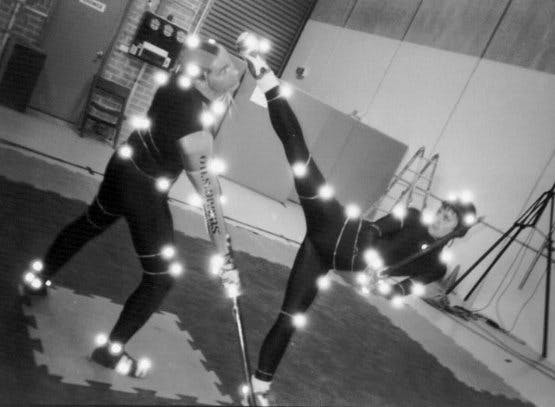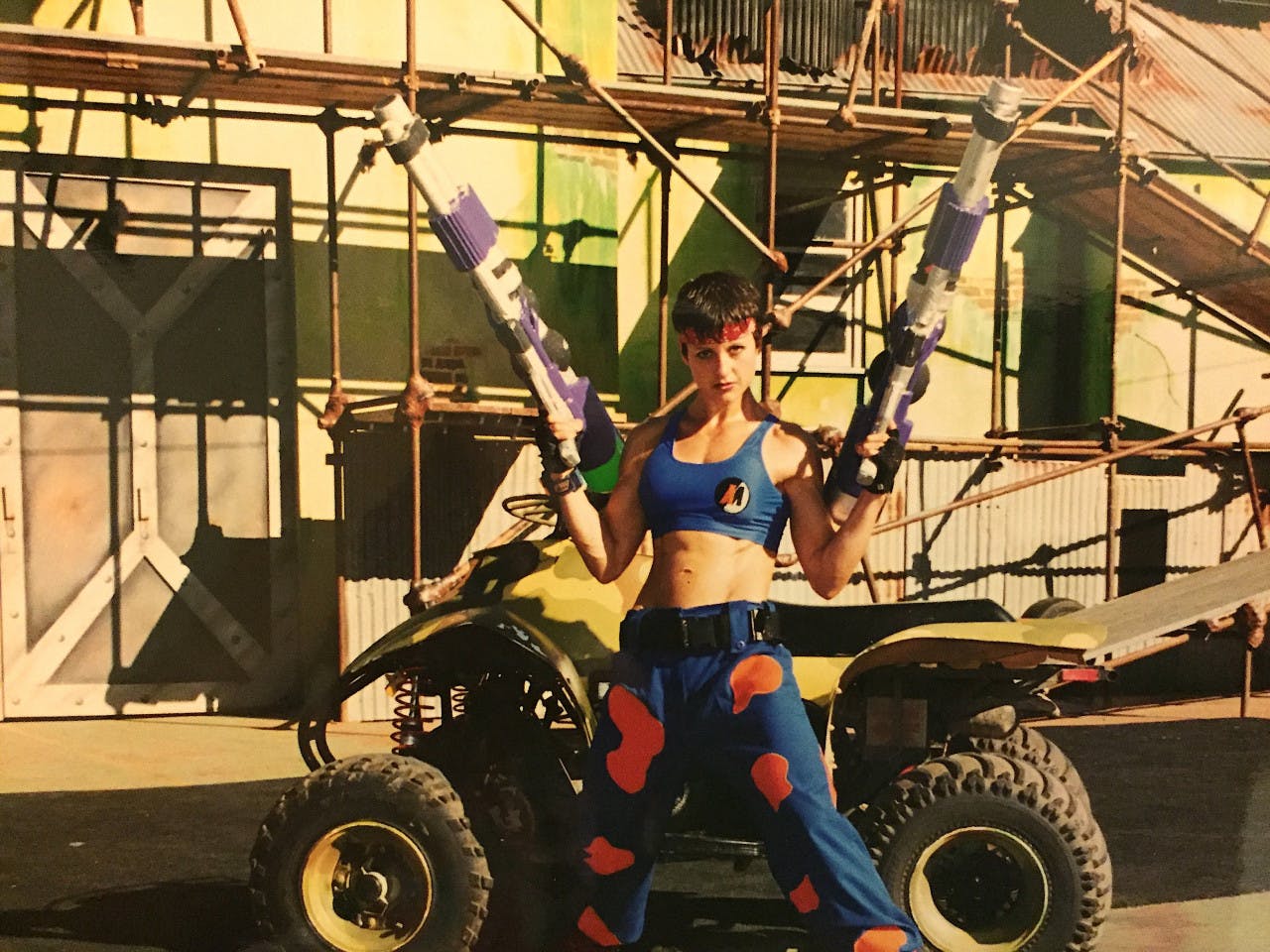Stunt Performing: The Art of Falling

Being pushed and shoved. Getting punched and kicked. Just another day in the office.
Being hit by a car. Getting blown up. Just another day in the office.
Yes, I am talking about the, for many years, overlooked unsung heroes of the entertainment industry: Stunt actors. I have been privileged to have been part of that unique group of people. Some call us daredevils. Others call us adrenalin junkies. Still, others refer to us as fools. We are none of these.
We are actors, and the risks we take are calculated risks. In fact, if performed correctly and according to plan, our so-called foolish acts of bravado are safe. Just like any performance, they are an illusion intended to scare, shock, enchant, and transport into the realm of imagination and make-believe, simply to entertain. We are not risk-takers who simply jump off cliffs for their own exhilaration or adrenalin fix. We do what we do to touch our audiences. We are all performers at heart. We need spectators to make our act complete. Sure, a bit of “what a rush” comes into it. We all love the sense of excitement and apprehension, but ultimately, we do what we do for you. For our audiences.
So how do you become a stunt actor? Personally, I have pretty much fallen into it – pun intended.
Who am I? I am a professional stunt performer as well as an actor and writer. My background is in theatre. I fare from the magnificent world of live performance. I have a bachelor of theatre and script writing and directing. Personally, I believe that both have enhanced my stunt work. I think acting is essential to becoming a convincing stunt performer, but more of that later.
Apart from loving the stage, I have always admired martial arts and gymnastics. It was the ability to flip, roll, dive, spin, and fly through the air that appealed to me. The power to defy gravity, to defy human limitations. One of the most outstanding examples of that aptitude is my all-time favorite, Jackie Chan. Jackie is a master performer and tremendously talented martial artist who has a thorough understanding of how to engage the audience. Inspired by Jackie and his DRUNKEN MASTER, a movie I must have watched at least a thousand times (on a video cassette smuggled into a country under a strict communist regime), I started studying martial arts. I began with Tae Kwon Do, later tried Wu Shu and Wing Chun, eventually finding my place in a Jow Ga Kung Fu Academy in Sydney. Along with martial arts, I also started enjoying other physical challenges, such as rock climbing, rap jumping, and horse riding, to name a few.

All of these came in handy when I discovered physical theatre and fell in love with its form. Once I finished my degrees, I started acting in various live shows. Soon, I became aware of a curious pattern; I was always the one to get pushed around, slapped, kicked, punched, and generally abused on stage. I figured I might as well follow through with this and see where it takes me.
I worked as a motion capture actor, kissing all sense of dignity goodbye when I donned one of those full-body suits, cap and all, and covered from head-to-toe with numerous luminescent balls. I became the cartoon version of Xena: Warrior Princes, Lara Croft, Wonder Woman, Poison Ivy, and even your friendly neighborhood dinosaur.
Eventually, I landed a role in my first live-action show, aptly named ACTION MAN, in the now-defunct Wonderland Sydney. ACTION MAN involved countless stunts, including falls and martial arts. This was indeed a great experience and baptism by fire. We performed in all weather and under challenging conditions. We had to adapt quickly, learn new choreography on a daily basis and acquire new skills to thrive in the ever-changing environment. We also learned about the value of trust and working together.
Some of those who came through the ACTION MAN ranks included stunt masters Mike and Mark Duncan and martial arts star, Bran Foster. The skills and lessons learned at Wonderland formed an excellent foundation for a career in the business. I always say roles in amusement parks or live-action shows are nothing to look down on. They are superb training grounds for a successful future in the entertainment industry, both as actors and stunt actors.
Eventually, I was offered roles at Universal Studios and worked there for nearly three fantastic years. I met amazing people, including Captain Dale Dye and Julia Rupkalvis, who shared their experiences and friendship with me. During my time on the TERMINATOR 2 and WILD WILD WEST shows, I not only learned new skills and gained invaluable experience, I realized the importance of proper training and working with qualified performers.

That is why, once I returned to Australia (and after having my first daughter), I decided to get accredited as a stunt actor by the Media, Entertainment, and Arts Alliance (MEAA). Being accredited is compulsory for anyone wanting to work in film and on TV, and this is not only to ensure a high standard but also safety. Knowing you are working alongside professional and certified stunt actors gives you the sense of safety and security needed to perform stunts. Once I gained my accreditation, doors opened. They led to work in film, including a super exciting shoot on the SUPERMAN RETURNS movie and performing on TV in various fantastic shows such as HOME AND AWAY, SEA PATROL, PACKED TO THE RAFTERS, and many others.
So, what do you have to do? Naturally, grading procedures may vary from country to country, but most will have similar requirements. The selection criteria involve being proficient in four out of five possible categories. These include Body Control, Heights, Vehicles, Animals, and Water. All applicants must be competent in Body Control and three of the four remaining categories. Naturally, you have a choice of what skills within each category you will demonstrate. Needless to say, this is the time to show off your skill and talent. That said, I recommend only demonstrating skills you are genuinely proficient in. Having a long list of different skills that you are barely able to perform will be detrimental to your grading application. Short and sweet and less is more are just two idioms that pop to mind. Show your strengths only.
Now, let’s briefly examine each category. Body control is the most essential category and the only one that is compulsory and requires stunt training. In fact, since I became accredited, the MEAA introduced a mandatory 6-month general stunt training by a recognized stunt trainer or institution. Body control competency must be demonstrated in various basic stunt skills, including basic falls, rolls, fights, and mini-tramp work, as well as proficiency in another body control field. Body control is divided into two sub-categories: Physical and Fighting. Physical control includes gymnastics, trampoline, high diving, snow skiing, or snowboarding. Fighting control includes martial arts, boxing, wrestling, fencing, and theatrical fighting.
Next, we come to the second category – heights. Heights may include skills such as climbing, roping, falls of a minimum of 6 meters, parachuting, hang-gliding, and more.
Category three involves vehicles. You must hold a nationally recognized vehicle license to apply for grading, and these can include car, truck, or bike licenses. On top of that, you must show proof of the successful completion of a recognized defensive advanced driving course.
Category four comprises animals such as horses, camels, or bulls, either driving or riding. This category includes dressage, jumping, eventing, western pleasure, cutting, rodeo, or carriage driving.
Finally, we come to category five – water. Like the other categories, water includes numerous skills such as swimming, diving, water skiing, surfboarding, or yachting. You may also choose to gain a bronze medallion or equivalent in Life Saving.

However, to be able to list any of these skills, you must show proof of a minimum of one year of active participation and have evidence of either competition or a reference from a recognized instructor. You also need to have written proof of your training, which includes keeping logbooks that must consist of the date of your training, details of the type of activity performed, and the level of proficiency attained. It also must include the name of the graded stunt persons or stunt coordinators who supervised your training session and their signature.
Now, the next part can often be tricky since it generally requires help from someone. You must provide recorded evidence of your abilities, so ensure everything you do and all stunts you attempt are recorded and show you in the best possible light. Though it is not required, it might be a good idea to use the services of a professional editor to create an expertly executed showreel. A word of advice, make sure it is evident at all times that you are indeed the person performing each and every stunt on your showreel.
Finally, you must complete a senior first aid and provide two letters of recommendation from one stunt actor and one stunt coordinator with whom you have personally worked and trained. Once you have compiled all your evidence, you must submit it to the stunt committee for grading. If your application has merit, you may be called for an interview with the committee. This was the part I thoroughly enjoyed. Why? It gave me a chance to share my passion for performance, my beliefs about the work of a stunt actor, and what I was hoping to bring to the entertainment industry. So, one last word of advice: be sure you know why you want to become a stunt actor. It is not about the money or the daredevil stunts, those you can do in your own time. It is about storytelling, about creating an experience for your audiences. But that is another chapter.
Once you pass your grading, you become Stunt Action Person (SAP). Basically, you become the equivalent of a provisional driver. You are allowed to work on set and perform in background action and group stunts. This allows you to gain on-set experience and perfect your skills. After the required number of days on set, you can go for your Stunt Actor grading. This is like the initial grading with the addition of fire as a skill and the demonstration of advanced stunt skills gained during your provisional period.
After you are graded, the really hard work begins. This can be a long and, at times, disheartening process. Just like acting or writing, there is a lot of waiting and a lot of disappointment. You must not let that deter you. Keep training, keep honing your skills and keep networking. The stunt industry is very much based on word of mouth, so make contacts, get out there, go to stunt gyms, and make sure people know who you are. Make sure not to burn any bridges, ensure you are always professional and help whenever possible. Ensure that if you use social media, and who does not, your posts promote you and show you in the best possible light. Make sure your posts don’t bite you in the derrière. Be kind in your posts and shout out to others who have succeeded. Celebrate the successes of others. It will all make an enormous difference as you make your way into the business.
To all of you considering getting into stunts, I say give it a go but make sure you know why. Make sure you are ready, both physically and mentally. Be prepared for a lot of hard work, disappointment, and a fair amount of sweat, tears, and pain. That said, the work rewards are amazing, and the feeling of a well-done job is indescribable.
Next, we will discuss how to look after yourself once you attain your grading and begin working in the industry.
Happy stunting!
-- Zuzi
Let's hear your thoughts in the comments below!
Got an idea for a post? Or have you collaborated with Stage 32 members to create a project? We'd love to hear about it. Email Emily at blog@stage32.com, and let's get your post published!
Please help support your fellow Stage 32ers by sharing this on social. Check out the social media buttons at the top to share on Instagram @stage32, Twitter @stage32, Facebook @stage32, and LinkedIn @stage-32.






